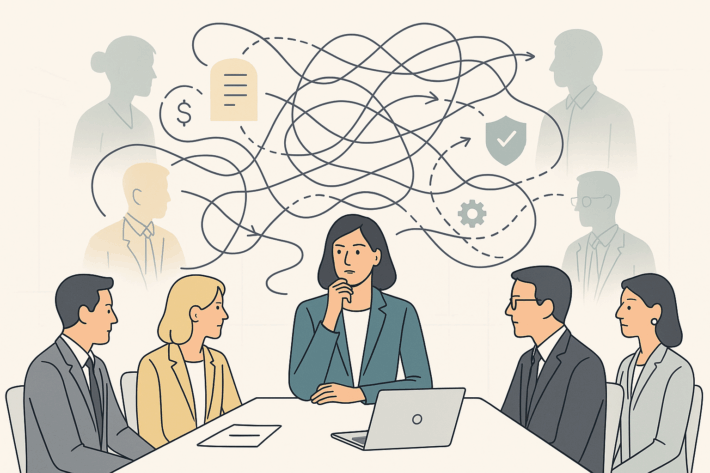How to Influence B2B Buying Committees: Psychology of Group Decision-Making in Global ABM
Most enterprise deals don’t hinge on one person. They stall…or succeed…because of how groups make decisions! That’s the real game ABM marketers are playing. Not just matching content to personas… but influencing a buying dynamic that’s full of friction, bias, and internal conflict.
Quick Answer
To influence B2B buying committees, your ABM strategy needs to reflect how groups actually make decisions. That means identifying key decision-makers and influencers, understanding their competing priorities, and delivering personalized plays that reduce risk, align with group goals, and earn internal trust.
What makes group buying so complex in B2B?
In most enterprise deals, there are at least 5 people involved in the decision, and most software buyers make purchasing decision as a team. That’s a fact from Gartner’s research on B2B buying behavior: https://www.gartner.com/en/digital-markets/insights/5-key-insights-about-the-software-buying-team
Each of those stakeholders brings their own:
- Functional priorities
- Internal goals
- Levels of influence
- Appetite for risk
- Understanding of the problem you’re solving
It’s not one journey. It’s many. And they rarely move at the same pace.
This is especially true in global ABM, where you’re not just managing vertical alignment… but also regional or cross-functional buy-in. In that environment, even a perfectly targeted campaign can fall flat if it doesn’t help the internal champions build consensus.
Why individual personas aren’t enough
Most ABM strategies start with persona work. That’s fine. But the moment you start engaging an enterprise account, you’re not selling to a person. You’re selling to a system of people.
Each person in that system sees your solution through a different lens:
- Finance cares about cost, risk, and payback period.
- IT cares about compatibility, security, and implementation lift.
- Operations cares about usability, training, and process fit.
- Procurement cares about control and compliance.
- Legal cares about risk exposure and jurisdiction.
- The actual end users care about their workflow and quality of life.
If your ABM content speaks to only one of these views, the others will poke holes in it. That’s how group deals unravel. Not because your message is wrong… but because it isn’t complete.
What psychological biases show up in buying committees?
This is where psychology becomes a superpower. Group decisions are rarely rational. Even in B2B.
Here are a few cognitive and social psychology concepts that show up again and again:
- Commitment bias: People defend early choices to avoid admitting they were wrong. If one stakeholder champions a platform, others might fall in line to protect team unity, even if it’s not the best option.
- Social proof and herd behavior: People look to others to validate their preferences. If you can show who else on their team or in their industry has made a similar choice, that validation carries weight.
- Risk aversion: In enterprise settings, the fear of failure often outweighs the desire for innovation. Framing your offer as the safer, proven path reduces internal resistance.
- The Abilene Paradox: Sometimes, groups agree on a decision none of them actually want… because no one wants to challenge the group. It’s easier to go along with a mediocre decision than to fight for the best one.
- Future pacing: A subtle but powerful technique. If your messaging can help the group picture themselves after a successful implementation, i.e. how it makes their work easier, how it boosts their status internally etc., you make the decision feel real and achievable.
These aren’t academic theories. They are levers. And most ABM strategies don’t pull them.
How do you build ABM plays that address group dynamics?
Now we get tactical. Here’s what it looks like when you actually build plays around group psychology:
1. Start with a decision map, not just personas Chart out everyone who might influence the deal. This includes official decision-makers and behind-the-scenes voices. Assign each one a motivation, fear, and potential objection.
2. Build internal alignment tools Think beyond external content. Give your champions what they need to influence the room:
- Side-by-side comparison decks
- Internal FAQs
- Business case templates pre-filled with company data
- Short videos or 1-pagers for each stakeholder group
3. Personalize for the internal debate Don’t assume your champion will pitch you well. Make it easy for them. Equip them with:
- Executive summaries for finance
- Security one-pagers for IT
- ROI calculators with region-specific data
- Testimonials from similar departments in similar industries
4. Use consensus-based CTAs Instead of pushing for a demo, ask: “Who else would you want in the room to pressure test this?” You’re not just booking meetings. You’re shaping the decision journey.
5. Time plays around key alignment moments Sync campaigns with budget planning, QBRs, or leadership offsites. That’s when teams huddle and alignment matters most. If your content shows up then, you’re not just marketing. You’re supporting strategy.
What are some real-world examples of this working?
Example: Cross-functional ABM in enterprise software A global SaaS company targeting procurement teams found deals stalled at the legal and IT review stage. So they added:
- A “legal pack” with template contracts, risk statements, and jurisdiction clauses
- A “tech validation kit” including architecture diagrams, SOC2 compliance docs, and API docs
Suddenly, the same accounts that ghosted at review stage started moving through procurement. Why? Because the ABM strategy didn’t just engage the buyer. It equipped them to win the internal argument.
Example: Using future pacing in ABM A marketing automation platform created a landing page for CMOs showing a 12-month rollout roadmap with milestone wins. Each milestone was tied to specific KPIs marketing leaders were accountable for. The language was focused on internal wins: easier reporting, faster pipeline attribution, and better visibility for their team.
That page outperformed their standard feature-driven content 4 to 1. Because it didn’t sell a tool. It sold a future the buyer could picture, and justify to their team.
TL;DR Summary
Most ABM strategies miss the real decision-making layer: group psychology. To drive enterprise deals, you need to:
- Map the full buying committee
- Speak to internal friction, not just external benefits
- Build content that equips champions to influence others
- Use psychological levers like social proof, risk reduction, and future pacing
When ABM is designed for how people actually make decisions in groups, you don’t just generate interest. You generate alignment.
Want help building plays like this inside your ABM engine? Let’s talk.
Jahnavi Ray is a data obsessed marketing leader with 17+ years of experience driving demand, building GTM engines, and mentoring growth-stage B2B teams. She’s led marketing inside startups, scaled systems at global SaaS companies, and now shares her playbooks to help founders and marketers turn chaos into clarity, and pipeline into predictable revenue. When she’s not mapping growth ecosystems or coaching on GrowthMentor, you’ll find her practicing yoga, chasing her two gremlins, or building something meaningful in Toronto.


